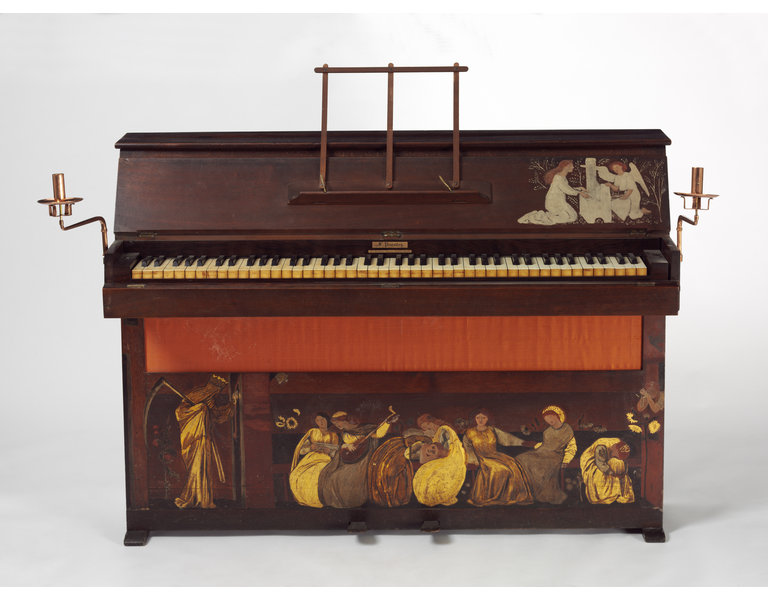
Ladies and Death, by Sir Edward Coley Burne-Jones (1833-1898). c.1860. Painted walnut panel for a piano manufactured by Frederick Priestly. 333 x 1267 cm. In the collection of the Victoria and Albert Museum. Photographed by Jacqueline Banerjee at the press view of the exhibition, "Edward Burne-Jones," Tate Britain, 24 October 2018-24 February 2019, reviewed here. This item was on loan for the exhibition, and presented more as an early painting, fixed to the wall, than as furniture decoration.

Whole piano, image downloaded with permission from the V&A Collections website.
Among the wedding presents that Burne-Jones and his wife received was a small upright piano, which the artist put his own stamp on. His wife Georgiana recalls:
Mrs. Catherwood gave us a piano, made by Priestly of Berners Street, who had patented a small one of inoffensive shape that we had seen and admired at Madox Brown's house; we had ours made of unpolished American walnut, a perfectly plain wood of pleasing colour, so that Edward could paint upon it. The little instrument when opened shows inside the lid a very early design for the "Chant d' Amour," and on the panel beneath the keyboard there is a gilded and lacquered picture of Death, veiled and crowned, standing outside the gate of a garden where a number of girls, unconscious of his approach, are resting and listening to music. The lacquering of this panel was an exciting process, for its colour had to be be deepened by heat while still liquid, and Edward used a red-hot poker for the work. [207]
The design was, apparently, based on that of lovers in the medieval Triumph of Death in the Campo Santo at Pisa (Crawford 6). It seems an odd choice of subject for decorating a wedding gift. But perhaps this recognition of the imminent threat of death serves as a reminder: life should be lived in the moment, in the enjoyment of art. As in Burne-Jones's early watercolours, there are bright highlights here, including the gold of Death's crown. In composition (that is, the disposition of the women), this looks forward to the Briar Rose sequence of 1874-90.
Captions, text and formatting (as well as first photograph), by Jacqueline Banerjee. You may use these images without prior permission for any scholarly or educational purpose as long as you (1) credit the photographer and Tate Britain or the V&A, and (2) link your document to this URL in a web document or cite the Victorian Web in a print one.
Related Material
- Another piano more ebulliently decorated by Burne-Jones
- Victorian Furniture including pieces decorated by Burne-Jones
- Review of the Edward Burne-Jones exhibition, and accompanying book
Bibliography
Burne-Jones, Georgiana. Memorials of Edward Burne-Jones, Vol. I. London: Macmillan, 1904. Internet Archive. Contributed by Brigham Young University. Web. 28 October 2018.
Crawford, Alan. "Burne-Jones as a Decorative Artist." Edward Burne-Jones. Victorian Artist-Dreamer, by Stephen Wildman and John Christian, with essays by Alan Crawford and Laurence des Cars. New York: Metropolitan Museum of Art, 1998. 5-24.
Created 28 October 2018